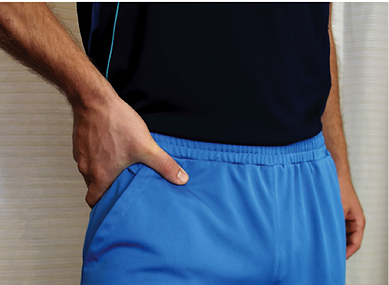YOUR PHYSIO
Condition directory
Labral Tears

We have previously mentioned labral tears on our page discussing impingement of the hip joint, otherwise known as femoroacetabular impingement (FAI). Labral tears can exist with or without hip impingement (FAI). To review this information click here. The acetabulum is the socket part of the ‘ball and socket’ hip joint. The acetabular labrum is the supporting circular, gristle-like cartilage or ‘fibrocartilage’ around the rim of the socket. It deepens the hip joint by 21%. It functions to seal the hip joint, protect inter-joint cartilage, enhance stability, distribute load evenly throughout the joint and provide proprioceptive feedback (meaning that it helps relay messages to the brain regarding hip joint position).
A labral tear is characterized by either a defect or a small rip in the labrum itself or when the labrum pulls away from the acetabulum. Only the outer third of the labrum is penetrated with blood vessels. Given the poor supply of blood to the labrum, it is a structure that does not heal well. It typically affects just one side. Symptomatic labral tears may cause a sharp catching pain, giving way and a sensation of locking of the hip during activity. We tend to call these features ‘mechanical’ symptoms. Some people may experience a grinding or popping sensation when they rotate their hip outwards, especially when the affected leg is already positioned away from the other leg (in abduction).
Typically, people with a labral tear experience a subtle, dull, activity and/or position-related hip pain. This pain is often felt towards the outside of the hip joint and towards the groin. Individuals often cup their hip with their hand to display the area of pain; this is known as the ‘C’ sign.
 Some people experience referred pain. This means pain from the hip is felt in other areas such as the buttock, leg and lower back. Unlike osteoarthritis, hip range of movement may be well preserved. At times, movement is reduced and the hip can feel stiffer. It is worth noting that even if you have a known labral tear, this does not necessarily mean you will suffer symptoms. Indeed, it is known that 25% of individuals over the age of 50 have labral tears, but no symptoms. The incidence of labral tearing increases with age, indicating that some deterioration may be associated with the normal aging process.
Some people experience referred pain. This means pain from the hip is felt in other areas such as the buttock, leg and lower back. Unlike osteoarthritis, hip range of movement may be well preserved. At times, movement is reduced and the hip can feel stiffer. It is worth noting that even if you have a known labral tear, this does not necessarily mean you will suffer symptoms. Indeed, it is known that 25% of individuals over the age of 50 have labral tears, but no symptoms. The incidence of labral tearing increases with age, indicating that some deterioration may be associated with the normal aging process.
However, some individuals do develop symptoms secondary to a labral tear. Pain from a labral tear is often due to repetitive movements or prolonged loading in static positions. Sports that produce high loads through the hip include running and sprinting. Alternately, football, ballet, hockey and golf generate repetitive lateral rotation through the hip. 75% of labral tears can just simply develop. The presence of a labral tear may predispose the hip to developing osteoarthritis (OA). There is evidence that shows the presence of a labral tear doubles the risk of an individual developing OA. However, it is worth noting that not everyone with hip OA suffers with symptoms.
Initial treatment for symptomatic labral tears is non-surgical. Non-surgical treatment involves addressing lifestyle factors which predispose an individual to excessively load their labrum through sport or occupation. To find out about lifestyle and MSK health click here.
Exercises that promote control around the hip joint can be useful for labral tears. The following exercises are worth trying in the first instance:
Your GP may also discuss medication management options with you.
If your symptoms are not improving with simple exercises and analgesics discuss a referral to the MSK service with your GP.